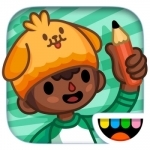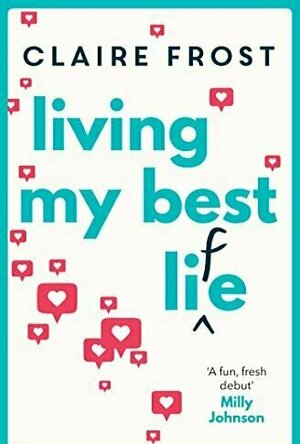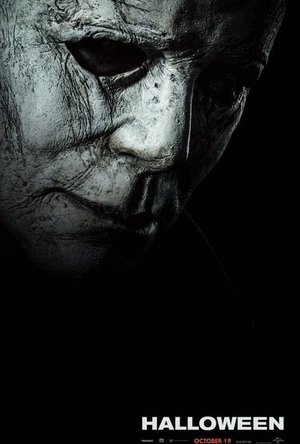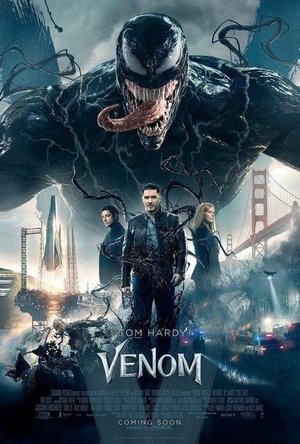
Piano with Songs
Music and Games
App
Piano Free has the largest song catalog of any piano on the app store. With over 1,500 songs to...

ilocateMobile - Track a phone
Social Networking and Utilities
App
Question: Why you need to download Track My Phone app ? Answer: You need this app to locate a...
Ivana A. | Diary of Difference (1171 KP) rated Living My Best Li(f)e in Books
Oct 2, 2020
We have one woman - Bell - who is about to turn 40, and her comfort is broken when her man decides to leave her after years of togetherness.
We also have another woman, Millie, in her mid-thirties, and her little son Wolf (who names their child Wolf?). Millie fell in love with a football star Louis and had a child with him. To her disappointment, she realized the man she is in love with is the most unreliable parent in the world. She also happens to be an Instagram star, that only shows the world what she wants them to see.
While the followers see expensive dresses and well-behaved child, the reality shows that Millie takes a picture of the dresses and returns them to the shop, unable to afford them. She is also receiving calls from Wolfie's school that he has not be behaving in his best manners.
When these two women accidentally meet, they turn out to be besties. In fact, they became besties so fast, that I had to laugh out loud at how bizarre and unrealistic that was. Do you ever go to a coffee shop, say hi to a person, and then THE SAME DAY, THE SAME CONVERSATIONS you both start sharing your deepest secrets? Yes - it was that bizarre.
I really wanted to love '' Living My Best Li(f)e '' , as it captured a lot of problems. But it only captured the surface of these problems, then solved them instantly and moved on. And I wasn't satisfied. There were so many little plot problems that the author kept adding to the book randomly to keep the story going, and kept resolving them one by one - no anticipation, no hunger for one more chapter. Disappointing.
First of all, all the characters were not realistic. We have this woman that keeps saying she can be on her own, but she also keeps complaining every second of the day.
Then, we have this other woman, who seems like such a person that everyone is looking up to, but in fact, she is too scared to say no to her ex-love and father of her child, and she keeps up with all his nonsense on a daily bases.
Last, but not least, we have the 5-year-old Wolf boy, who talks like a 20-year-old boy, but behaves like a toddler, and I don't know how to react to that.
And finally, we have ''the rest of the characters'', who were mentioned and had their own roles in the book, but didn't have enough of a back story or air-time in order to be remembered by the audience.
The author also introduced us to a plot twist, that came out unexpectedly - but suddenly the government were about to destroy their community center and it was up to them to collect money and save this place in a record time. How convenient for the story, right? With no building up to it, the problem just raised from the ground... And you can all imagine the happy endings and soppy stories that followed with their success.
So yeah - that got me, and I didn't believe it for a second, and therefore this review. I really wanted to love Living My Best Li(f)e, but nothing worked out. Disappointing characters, plots and lack of thrill. Not a great experience for me. I wouldn't recommend it, but if you choose to read it, I would love to know what you think! <3

Deezer: Music Player & Radio
Music and Entertainment
App
Discover the music you love with Deezer. With access to millions of tracks, create endless playlists...

hayu - reality TV shows on demand & celebrity news
Entertainment
App
The hayu app is the home of the best reality TV and the juiciest celebrity gossip – all in one...

Vivino Wine Scanner
Food & Drink and Shopping
App
Buying wine in Vivino is simple and easy. Vivino has taken the guesswork out of wine shopping. ...

Toca Life: School
Education and Entertainment
App
Grab your backpack— it’s time for Toca Life: School! Teach a class, pick a locker and have a...

Embark: User friendly personalised nautical charts
Navigation and Travel
App
Embark gives you FREE and updated charts, crafted on data from the Hydrographic Offices. A smooth...
Bob Mann (459 KP) rated Halloween (2018) in Movies
Sep 28, 2021
There’s such a familiarity with the content of these films that it’s difficult to put yourself back in 1978 for Jamie Lee Curtis‘s original battle with Michael Myers when the teen-slasher genre was in its infancy. Arguably “The Texas Chain Saw Massacre” four years earlier booted the 70’s/80’s genre; but thanks to its huge success John Carpenter’s “Halloween” opened the flood-gates… or should I say, blood-gates.
The plot.
40 years after the terrifying events of Halloween night in Haddonfield, Illinois, Michael Myers is still mute and incarcerated in a psychiatric unit being studied by Dr Sartain (Haluk Bilginer). He is joined by two investigative journalists – Aaron Korey (Jefferson Hall) and Dana Haines (Basingstoke’s-own Rhian Rees: “Where are your loos?”… classic!). They are keen to reunite Myers with his nemesis Laurie Strode (Jamie Lee Curtis) to watch the fireworks.
Strode is unfortunately damaged goods: still mentally traumatised and with failed marriages and a child taken into care, she lives in a fortified home in the middle of the woods. But she knows she has a date with destiny. As Halloween 2018 approaches, an ‘incident’ puts Myers on a collision course with Haddonfield’s teenage population all over again.
The turns.
Wow… you forget what an effective actress Jamie Lee Curtis is and here she absolutely owns every single scene she’s in, bringing enormous energy to the screen as the paranoid but ever-prepared hunter-in-waiting. The original Halloween was Lee Curtis’s movie debut and the film that made her a household name, and it almost feels like this is a passion-project for her to say “thanks for all the fish” for her career. Impressive.
As her eye-rolling daughter, Judy Greer rather pales in comparison (I found her character is a bit whiny and annoying), but the acting stakes pick up again with Andi Matichak as the granddaughter Allyson.
Of the other teens, Virginia Gardner is particularly effective as Vicky: the cute “favourite” babysitter who you can’t help but empathise with.
The review.
It’s very easy to make a very bad slasher movie, but this isn’t such a movie. Although having a wonderfully retro feel (when is the last time you saw “traditional” opening titles like this?) and despite mining every horror cliché known to man (ALWAYS look in the back seat when you get in a car!) it’s all obviously been done with loving care by the director David Gordon Green.
Above all, the director knows that what’s more scary than seeing violent murders is what your imagination can visualise happening off-screen. Don’t get me wrong, there is some SERIOUS gore meted out, with a few ‘cover your eyes’ moments. However, a good proportion of the violence is not shown, and very effective that is too, supported by Carpenter’s classic and insistent theme and some kick-ass foley work to add spice to your imagination!
The script (by the writing team of David Gordon Green, Danny McBride and Jeff Fradley) also wickedly plays with your darkest fear of where the plot *could* go if it wanted to: in a brilliant piece of misdirection (you’ll know the scene) your “OMG surely not” nerves twang and then un-twang with relief.
The script also works well to help you care about the teens on the menu, in much the same way as “Jaws” did with the tourists to Amity Beach.
Where the plot nearly lost me was in a rather daft twist before the final reel (which actually made more sense of what happened in the first reel, but was still hugely improbable). The ship rights itself fairly quickly (if messily) and normal order is resumed for the finale it deserves.
Final thoughts.
I’m not really a “horror nut” but this was popcorn horror of the best sort and I enjoyed it. Reverential to the original classic, it made for some entertaining reactions in the sparsely populated showing I attended: I imagine if seen in a packed auditorium on a Saturday night (or perhaps tomorrow night!) it would literally be a scream.
One’s thing for sure: when I got into my car in the dark cinema car park, I did take a sneaky look into the back seat!
Bob Mann (459 KP) rated Venom (2018) in Movies
Sep 28, 2021
The plot
Tom Hardy plays Eddie Brock, a San Franciscan investigative reporter who is engaged to hot-shot lawyer Anne Weying (Michelle WIlliams). Brock is a bit of a maverick and always tends to push things a bit far, both at work and at home. Brock targets for his latest investigation Carlton Drake (Riz Ahmed): a billionaire space pioneer (I hope the producers got WELL lawyered up!) Drake is a Bond-style megalomaniac who is intend on saving mankind by merging humans with aliens to create a symbiotic organism. Not wishing to go through all the nampy-pamby clinical trials stuff, he is doing live research on vagrants and others who “won’t be missed”… with generally negative results. Infected accidently with the symbiont called Venom Brock’s future hangs in the balance: the meld will either kill him or else a new superhero will be born. (No guessing which!)
Review
For anyone with one foot already in the Spiderverse, Eddie Brock and his alter-ego Venom have appeared before, in the convoluted and pretty poor Tobey Maguire sequel “Spider-Man 3”. In that film Eddie (played by Topher Grace) was the boyfriend of Gwen Stacey (then played by Bryce Dallas-Howard) who was similarly infected by an alien symbiote and was transformed into Venom.
This new Venom incarnation is a Sony Pictures production “with” Marvel Studios, and although featuring a Stan Lee cameo it never quite feels like a Marvel picture. Posher critics have described it as “tonally inconsistent”…. which is posh-critic language for “it’s fecking all over the place”! And they are right. It veers suddenly from high drama and sci-fi action to plodding dialogue and Deadpool-style wisecracks with clutch-smoking rapidity. As such, the film never feels like it’s decided whether it wants to be at the po-faced Captain America end of the Marvel specturn or at the wise-cracking Deadpool/GotG end.
The Turns
Tom Hardy actually gets to spend a lot of this film without a mask over his face, which is certainly a novelty! And he gives it his all acting wise which will please his army of fans. But his pairing with the Oscar-winning Michelle Williams never feels comfortable: there seems little chemistry between the pair given that they are an “item”. None of this is helped by the grindingly turgid script which gives the pair, plus Reid Scott (“Dan” from “Veep”) as the third corner in the love triangle, some truly dire dialogue to spout at each other.
An act I did like in the film was Riz Ahmed as the “really bad guy” Drake. I found Ahmed extremely annoying in “Rogue One”, but here he slides into the smarmy evil role perfectly. A better script, like a future Bond film, would have benefitted from the turn!
Woody Harrelson also turns up in a mid-credit “monkey” as the supervillain Cletus Kasady, which meant nothing to me but certainly does to comic-book fans. (By the way, there is no “monkey” at the end of the film, but there is a 6 minute clip from the upcoming “Into the Spider Verse” cartoon feature tacked onto the end – at least of this Cineworld showing – which may or may not interest you).
A technical shout-out should go to Swedish composer Ludwig Göransson (who’s previously done “Black Panther” and “Creed”): an unusual soundtrack with odd electronica, eerie electric-guitar riffs for Eddie’s theme interspersed with exciting fast-paced action beats.
Final Thoughts
I must admit that from starting with a cynical “don’t want to know” approach to the Marvel Universe, the damn thing is slowly wearing me down into being kind of intrigued with what they are going to do next. This is not a classic Marvel flick, but for me it wasn’t nearly as bad as some of the critical reviews have made it out to be. I saw this alone: and we were quite entertained.


